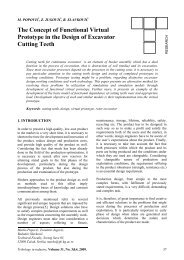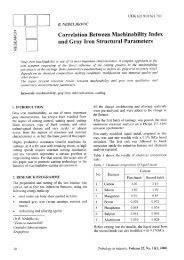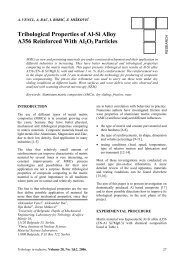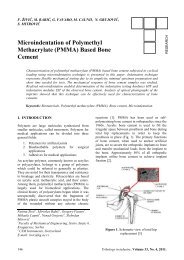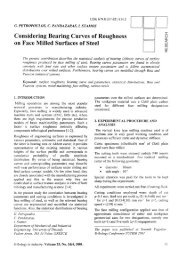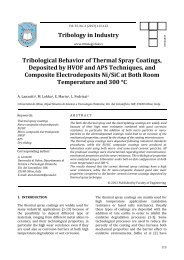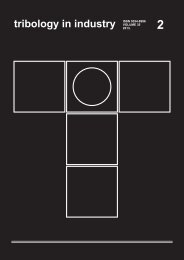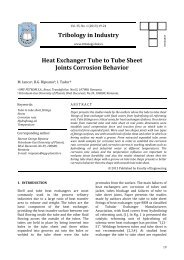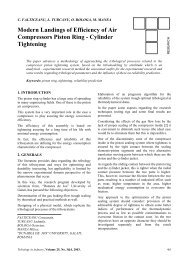No. 4, 1998 - Tribology in Industry
No. 4, 1998 - Tribology in Industry
No. 4, 1998 - Tribology in Industry
Create successful ePaper yourself
Turn your PDF publications into a flip-book with our unique Google optimized e-Paper software.
UDK 621:192.6.N4<br />
I<br />
O cc<br />
LU<br />
U)<br />
[!<br />
E<br />
M, BABIC<br />
<strong>Tribology</strong> and Energy<br />
Funttamenlcl problem that hurnanity is fac<strong>in</strong>g with comes from opposite requirements that are enforced<br />
simultaneously, for providitry stfficient amowt af energ for the growittg needs, for preservittg the non-restorable<br />
energt resources cnd for decreas<strong>in</strong>g ecological loads of the etwironment.<br />
Urgent need to rn<strong>in</strong>irnize this problem is apparent itt yiew of the powerful cleveloprnett of the new, so called<br />
environrmental technologies, like enetgt sav<strong>in</strong>gs, clean enerry, renewable enetry) resources, weste menagement,<br />
recyclirry, artd environmeril monito<strong>in</strong>g. Coruideitry the scenaios for the 21st century about the exponential<br />
growth of the enetgt cotuumptiot4 it is clear that the most important place belongs to enet&l sav<strong>in</strong>gs. Havbtg<br />
<strong>in</strong> m<strong>in</strong>d the dissipative nature of the tw'o basic tribological phenomena - fiction and wear, tribologt today, as<br />
the multidiscipl<strong>in</strong>ary concept, is accepted as ane of the most important chances for contibutiort, to general<br />
efforts for borh direct and <strong>in</strong>direct sav<strong>in</strong>gs of enetgl<br />
l.INTRODUCTION<br />
Fundamental probiem that humarrity is fac<strong>in</strong>g with comes<br />
from opposite requirements that are enforced simultaneously,<br />
for provid<strong>in</strong>g sufficient amount of energy for<br />
the grow<strong>in</strong>g needs, for preserv<strong>in</strong>g the non-restorable<br />
euerg/ resources and for decreas<strong>in</strong>g ecological loads of<br />
the envrronment. The degree of systematic deal<strong>in</strong>g with<br />
this problem is directly related to the degree of the<br />
country's development.<br />
In developed countries efforts for decreas<strong>in</strong>g this problem<br />
result <strong>in</strong> development of the new, so called environmental<br />
technologies, like the energy sav<strong>in</strong>gs, clean enerry,<br />
renewabie energy resources, waste management,<br />
rerycl<strong>in</strong>g, and environment monitor<strong>in</strong>g [1]. Consider<strong>in</strong>g<br />
the scenarios for the 21st century about the exponential<br />
growth of the energy consumption and further dom<strong>in</strong>ant<br />
part of fossil energy resources, it is clear that the most<br />
important place belongs to energy sav<strong>in</strong>gs. Hav<strong>in</strong>g <strong>in</strong><br />
m<strong>in</strong>d the dissipative nature of the two basic tribological<br />
phenomena - friction and wear, tribologSr ioday, as the<br />
multidiscipl<strong>in</strong>ary concept, is accepted as one of the most<br />
important chances for contribution to general effo(s for<br />
both direct and <strong>in</strong>direct sav<strong>in</strong>gs of energSr and ecological<br />
proteciion of the environment.<br />
In many countries (Engiand, Germany, USA, Japan,<br />
Canada, Ch<strong>in</strong>a) large funds were and are <strong>in</strong>vested today<br />
<strong>in</strong>to research that have as a goal to identify areas of<br />
largest "tribological s<strong>in</strong>ks" and to economically express<br />
Prof. dr kliroslav Babit, dipL <strong>in</strong>g.<br />
Faculty of Mechanical Engilrce<strong>in</strong>g, Kragtlevac<br />
losses and potential sav<strong>in</strong>gs, as well as to def<strong>in</strong>e ma<strong>in</strong><br />
directions of research, development and education <strong>in</strong><br />
order to realize estimated sav<strong>in</strong>gs [2-8]. lbk<strong>in</strong>g <strong>in</strong>to account<br />
the world experiences <strong>in</strong> this area, it can be expected<br />
that pay<strong>in</strong>g the adequate attention to tribology will<br />
result <strong>in</strong> sav<strong>in</strong>gs (of energetic character) of up to 27o of<br />
the gross nationai product. Up to 207o of these effects<br />
can be achieved without significant <strong>in</strong>vestments,<br />
A topic like energry sav<strong>in</strong>gs through tribology, assumes a<br />
broader approach to tribology as a science and technology.<br />
That approach should highlight direct easier to<br />
spot, but also <strong>in</strong>directhidden, relations between the contact<br />
phenomena dur<strong>in</strong>g the relative motion, that are of<br />
the dissipative nature, and their effects on different macro<br />
levels of express<strong>in</strong>g. Just the existence of such relations<br />
represents the basic power of the exponential development<br />
of tribology <strong>in</strong> the last thirty years.<br />
In this paper is given the global approach to problem of<br />
enerry sav<strong>in</strong>gs through tribologry. It enhances relations<br />
between micro-dissipative contact phenomena of friction<br />
and wear, and negative effects that are expressed as<br />
direct or <strong>in</strong>direct ener6y losses, as well as the estimate of<br />
basic tribological s<strong>in</strong>ks and possible energy sav<strong>in</strong>gs<br />
through tribology.<br />
2. DISSIPATIVE NATURE OF FRICTION<br />
AND WEAR<br />
Friction and wear represent fundamental processes dur<strong>in</strong>g<br />
the relative motion of solids, liquids and gasses, that<br />
are of stochastic nature, and that are manifested by<br />
dissipative, nonl<strong>in</strong>ear dynamic effects <strong>in</strong> the contact zones.<br />
1,4E<br />
Tibologt <strong>in</strong> <strong>in</strong>dwtry, Volume 20, <strong>No</strong>. 4,<strong>1998</strong>.



